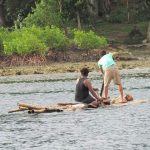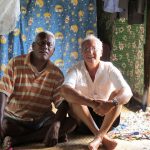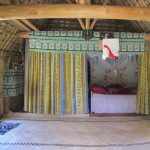2011
 |
| Savusavu |
Yes, we are still in Fiji. It is such a wonderful place that is seemed a shame to move on so soon.
Most cruising yachts clear into Fiji at Savusavu, spend a few days to recover from the Tonga passage, go as fast as possible to Suva then to Musket Cove and “bye bye Fiji, hello Vanuatu. Upon reflection we decided that we were in danger of doing the same thing. It seemed like there was a lot more to Vanua Levu than we had seen and we wanted to go back and start all over again. This meant two seasons in Fiji.
Entr’acte spend this past cyclone season safely “in the grave” at Vuda Marina under the watchful eye of Mr Bahros who cared for her as his own. Upon our return we checked into the seaside resort of First Landing and went to work. We found excellent foam to re-do the cushions throughout the entire boat. While Ellen sewed in air conditioned comfort, Ed did a complete re-rig of Entr’acte’s standing rigging.
 |
 |
| Muhammed and Mr Bahros | Making new cushions |
Our standing rigging was now 12 years old and the Norseman fittings were a whopping 33 years old and had been re-used four times. It was time to move on. So, sadly, the old Norseman’s were replaced with brand new Hayn HyMods. We now had all new wire, fittings, new mast tangs, chain plates and mast bolts. Our rig should be good for a long time to come.
We would be parting ways with John and Paula on Mr John for a while. They were setting out to Vanuatu, New Caledonia and Australia. Our plan for this season was to return to Vanua Levu and visit the really remote villages that are up on the North side of the Island but first we had to satisfy the Fijian Customs requirements.
To avoid a hefty import tax on Entr’acte we needed to clear out of Fiji, clear into some other country and then upon our return to Fiji we would be allowed another 18 months tax free. The easiest way to accomplish this would be to sail 300 miles Northeast up to the French Islands of Wallis and Futuna. We had all summer (winter when you are down under in Fiji) to do this so we set a leisurely course for Vanua Levu and our return to Savusavu. This is when things became decidedly interesting.
Sailing Fijian waters is quite the challenge. There are countless unmarked reefs, precious few navigation markers and few secure anchorages along Viti Levu’s North coast. Daylight sailing only and in good light to read the water. We made short hops all of them into the wind and there was plenty of it. It was brutal at times! We dubbed this season “The Fiji Challenge!”
Our new rig got a real test! This was the season of sailing to windward into heavy winds. For the entire six month season we did not use any of our light sails —not once! Two reefs in the main, small jib and the storm tri-sail were in constant use. By October we were to grow tired of all this wind both at sea and at anchor.
Savusavu was it’s usual delightful self. The Copra Shed Marina could not accommodate us this time because of the numerous rallies so we were adopted by Waitui Marina which turned out to be a wonderful discovery. Waitui had much more of a down home feeling. We finally felt like we were in the REAL Fiji.
A few weeks went by and it was time to head on up to Futuna. This again was a challenge. It is 120 miles from Savusavu to open ocean and safe deep water. The only route possible is very confined and again, unmarked. Fiji Customs rules are very strict. Once cleared out of Savusavu for Futuna we would be given one hour maximum to get under weigh and not permitted to stop ANYWHERE along our route–for any reason–regardless of wind, weather, lighting or sailing conditions. This meant that we would have to thread the pass between Vanua Levu and Taveuni as well as Texas and Florida reefs completely in the dark. Only then could we relax in safe deep water for the 150 mile passage to Futuna with Wallis Is another 200 miles beyond.
After much study of charts, weather maps and tide/current tables we arrived at a plan. We would clear customs at 15:00, be under weigh by 16:00 and get through the Point Reef Pass before dark. Hopefully, after sunset, the trade winds would diminish enough to make the 15 mile slog into the wind until we came under the lee of Taveuni Is. If we pushed hard and all went according to plan we could catch slack water at Somosomo Strait by 02:00 the following morning when the outgoing current would help us get by Texas and Florida Reefs in daylight and out to sea. Our plan worked to perfection at least until we cleared Udu Pt. As we came around to our course it was immediately obvious that while we could lay Futuna but without a wind sfift, it would be a very hard beat to Wallis.
We enjoyed a very lively close reach all the way to Futuna but unfortunately the wind shift never came. A day and a half later we were anchor down in the tiny French Island of Futuna. Tiny is the operative word. The harbour is almost non-existent, very rolly and only large enough for perhaps two boats if the weather is good but it was clear to us that we could not hang here for any length of time.
 |
| Futuna Harbour |
The Gendarme Pascal was most friendly and anxious that we have the proper clearance.
“When do you wish to return to Fiji? Ah, tomorrow? Bon!” He duly stamped our passports and wished us Bon Voyage.
“Merci, Monseur, we have our passports stamped but what about the clearance for the boat?”
“Mon ami, this is France. We do not do such things. Don’t worry, you have everything you need.”
It turned out that Pascal, while helpful, was new to Futuna and did not understand “The Fiji Shuffle!” We needed a Yacht Clearance, SOME piece of paper that would satisfy the Fijian Customs officer. Pascal insisted that no, he does not do that. It was only after much friendly persistence that he phoned Customs and when they heard the magic word “Fiji,” they said ‘Ah Fiji!, mais oui! Bring them to us at once!”
 |
| M. Pascal on Isle Futuna |
Futuna was a delightful little place and we wanted to stay for a few days but we had no French Franks. Since the bank opened only once a month it was impossible to exchange any money. We could not buy anything–nothing—not even a baguette. A real oversight on our part. We should have gotten some francs before departing Fiji.
Our sail back to Fiji was a “crackling reach!” We threaded all the reefs in pitch darkness with our hearts in our throats wishing that we could stop and anchor ANYWHERE until daylight but he authorities keep a serious watch and they would know. Once out of the lee of taveuni, the final 20 miles was a real honk! Small jib and tri-sail all the way. That Koro Sea can be a nasty place!
Back in Savusavu Sye, the Customs officer asked me “Clearance from your last port?” and just to see what might happen, I said “No, I don’t have one. They don’t do that in Futuna.” This reulted in a very hostile look. When I handed him our Clearance he smiled and breathed a sigh of relief. “It’s a good thing you have this. Someone just came in from Futuna two days ago without one and it is a $10,000.00 fine!” Fortunately our officer was very friendly and we explained to him the dilemma that we faced in Futuna over this and how we had to really push the officers for the clearance. Because of our explanation the other boat was excused his fine. Now that we were legal again we could relax and enjoy all of the Fiji that we missed last season.
 |
| Clearing Customs |
Viti Levu–the Big Island–while beautiful, is very tourist oriented. It is like all of Fiji very friendly with its lush hotels and resorts but it is NOT Fiji. The REAL Fiji is on Vanua Levu.
Throughout the season we visited villages that receive very few yachts. At one village we were astonished to be the first sailing yacht that had ever anchored in their harbour.
“What country is your flag from?” Now, THAT’S REMOTE!
Upon anchoring off a village our first obligation was to immediately go ashore in search of the chief to make our “Sevusevu.” This is a formal presentation of a gift for the village, usually a bundle of Yangona root to contribute to the village Kava supply. The root is placed on the floor of the hut facing the chief. At this point anyone in the immediate vicinity ceases activity to join in the Sevusevu. If the chief picks up your gift, it is accepted. Everyone claps in rhythm while saying a brief prayer which includes a welcome to the village, a wish for your continued health, safety for your voyage and a thank you for your visit and your gift. You are now officially welcome to stay in the harbour and visit the village. You are assigned a guide to explore the land and are welcome to take fruit, water and fish. If your Sevusevu is not accepted (not unheard of), you are not welcome. and must leave immediately.
Each afternoon the daily work ended to the sound of the kava being pounded. The sound was unmistakeable and could be heard from everywhere. Kava is a daily event in Fiji. It is made by pulverizing the root into a powder, mixing it water and straining it through a cloth. Kava is in the pepper family. It is non-alcoholic, non-narcotic and looks and tastes like MUD. Kava is the Fijian equivalent to afternoon tea, or a sundowner. NOTHING of importance takes place without first drinking Kava.
 |
 |
| Making “Sevusevu” | Fiji Water taxi |
There are some definite rules pertaining to village life. Aside from the obvious— No short pants-men or women—only long pants or skirts. No bikinis or brief swim suits. On those rare occasions when Fijian women enter the water they do so fully clothed. There were others that surprised us but were taken very seriously.
You may not wear sun glasses while in the village and never in the presence of the chief. You may not wear a hat while in the village. Only the chief may wear a hat unless he grants you permission to do otherwise. If you have a back pack, a purse or a camera, you must hand carry it and not sling it onto your back or shoulder. Ask permission to take any photos and if as in one case the chief says “tomorrow,” abide by it. All he really wanted was to shave and clean up for the photo.
 |
 |
| Chief Lai of Korinosolo Village | Mother’s Day in Navatu Village |
If the chief says “Tomorrow, church, 10 o”clock!” Take it as a command and plan on it. He will be waiting for you on the beach and a host family will already be preparing tea and lunch for you. And when you go to church, know that at some point you will be expected to speak and tell everyone who you are, where you come from and why you are here.
“I am Edward, son of Edward of United States and I have come a long way across this big ocean in my little boat to visit this famous land about which we studied in school as children.”
It was like a scene in some corny movie but it was very real. The congregation all applauded and shouted “Io,Io!” while the chief cried. By the time we arrived for lunch, everyone in the village knew our story. News travels fast in these villages.
The villages are traditional. They choose to live in the old way– simple grass huts, no electricity, one source for village water. No TV, no internet. One small led light bulb connected to a small battery / solar panel–this light was at the entrance to the church. The huts were spotlessly clean. Cooking was done over a wood fire. If the village did not have a school, the children were transported by boat to a school in a neighboring village. Everyone was clean, healthy and well educated.
 |
 |
| Koroinosolo Village | Each village has a school |
At Koroinosolo, Chief Lai stopped school so we could visit with the children. In Navatu village we were invited to Mother’s Day family dinner. In Dakuniba we were required to come to the house each night for tea and Kava. And in Viani Bay there was Jack Fisher’s 70th birthday Party.
 |
 |
|
| Jack Fisher 70th Birthday | David Hibbard Dakinuba Village | Rainbow Reef |
Viani Bay was unique because it adjoins the famous Rainbow Reef. Jack Fisher knows these reefs and currents intimately and for $10.00FD ($5.00 US) he will take you out to the best spot for the day depending on weather, sun and tides. Pete Allen on French Kiss had his own dive compressor so we enjoyed weeks of unlimited diving on Rainbow Reef.
When it comes time to leave a village it is important to announce your impending departure. The village then makes a “Meke.” This is a formal presentation of food and gifts to see you on your way and a prayer of thanks for your visit and for your health and safety on your continued voyage.
 |
 |
| Traditional Fiji Bure | Hut Inside |
The Fijian idea of wealth is not how much one accumulates but how much one gives away. You give a gift to someone and they give something back to you which is much more than you gave them. Then you reciprocate and so it goes,back and forth, up and up and—-STOP!!!! Village life could be exhausting! We can not decide if it was more difficult to be a host or a guest. What a delightful place.
The cyclone season is upon us and the rain has begun. It is time to return Entr’acte to the care of Mr. Bahros and “The Grave” for a well deserved rest.
Our plan is return to Arizona, play a few jazz Concerts with our quintet–the West Valley Jazztet and then next season, depart Fiji for Vanuatu and New Caledonia and perhaps Australia and another rendezvous with Mr. John.
The West Valley Jazztet
To see the West Valley Jazztet in concert click below:
Birt’s Bistro March 14, 2012 Birt’s Bostro Aprul 11, 2012
Stay tuned for further developments.
